
Reading & Resources
School Administrator, January 2018
Book Reviews
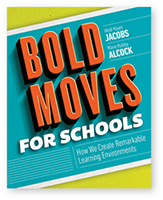 Bold Moves for Schools: How We Create Remarkable Learning Environments
Bold Moves for Schools: How We Create Remarkable Learning Environments
by Heidi Hayes Jacobs and
Marie Hubley Alcock, ASCD, Alexandria, Va., 2017, 193 pp. with index, $31.95 softcover
Bold Moves for Schools: How We Create Remarkable Learning Environments, written by educational consultants, Heidi Hayes Jacobs and Marie Hubley Alcock, challenges educators at all levels to think and act boldly. Boldness is essential, the authors argue, because too often school improvement efforts for “tomorrow’s schools” end up looking like yesterday’s schools with a few tweaks.
Tweaks are not acceptable when seismic shifts are needed. Grounded with a focus on the evolving nature of learning itself, the authors inspire us to embrace deep levels of personal and systemic change within the context of a “refreshed pedagogy.” In essence, the compelling need for change and the strategies to drive it are presented as new principles of learning that redefine (among other things) titles, job descriptions, relationships, curriculum platforms, structures and learning environments.
A particular strength of this comprehensive and well-organized book is the overarching framework that examines beliefs and practices through a “clusters of pedagogy” lens. The pedagogical clusters include: antiquated (what do we cut?); classical (what do we keep?); and contemporary (what do we create?). This easy to apply framework, complimented with a wide array of tables, charts, self-assessments and tools make this book an excellent resource for any school or district-wide leadership team.
Bold Moves for Schools is not for educators looking for piecemeal fixes or to tinker around the edges. It is, however, an excellent resource for those imaginative and courageous leaders who are committed to boldly transitioning from the “old school” to contemporary learning environments and innovative practices that deeply engage all learners. With vision and coherence, the book provides a user-friendly map and the navigational tools needed to support the journey.
Reviewed by Mary B. Herrmann, clinical assistant professor, University of Illinois at Urbana-Champaign
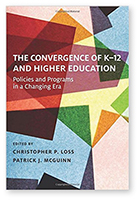 The Convergence of K-12 and Higher Education: Policies and Programs in a Changing Era
edited by Christopher P. Loss
The Convergence of K-12 and Higher Education: Policies and Programs in a Changing Era
edited by Christopher P. Loss and
Patrick J. McGuinn, Harvard Education Press, Cambridge, Mass., 2016, 296 pp. with index t, $32 softcover
School leaders generally have so much to focus on in their daily work lives that they seldom get a chance to stop and take a broad view of what is currently and potentially happening in their profession. If this situation sounds familiar, I would like to encourage you to stop and make the time to read The Convergence of K-12 and Higher Education: Policies and Programs in a Changing Era, edited by Christopher P. Loss (associate professor of higher education and Chancellor Faculty Fellow at Vanderbilt University’s Peabody College) and Patrick J. McGuinn (professor of political science and education chair of the political science department at Drew University). Their direction of the content of this text provides a much-needed perspective on the current state of the educational landscape, from K-12 programs to college, and the ways these discrete systems are merging.
The timely topics selected for the text provide firm theoretical, empirical and legal underpinnings for educators hoping to condense the chasm that traditionally exists between these two educational entities. Taking a historical lens of federal educational policy, the editors deliver a decidedly practical and organizationally focused narrative about issues that caused the two systems to be considered isolated units, while discussing the trends and advances that are supporting and accelerating the “convergence” of the two systems.
Setting the federal policy stage that supports both separate and more unified systems, the text talks about changes that have occurred to narrow the separation between the systems. Issues related to sociopolitical initiatives and events such as “The Great Society,” “Sputnik,” the “GI Bill,” the “War on Poverty,” civil rights advances, school accountability and federal funding of both systems are considered in a concise, yet comprehensive perspective. This historical coverage alone is worth the read, as it covers so many events, legal initiatives and policy overtures that have impacted the field of education.
Teacher policy, institutional assessment and accountability, making college accessible to all and the impact on technology within educational settings are also covered to provide a balanced presentation from both the K-12 and higher education perspectives. The remainder of the book focuses on issues related to globalization, as well as other factors the editors see as supporting and encouraging the “convergence” between the two systems.
For individuals wanting a text that provides a solid presentation of educational history and considers the impact on current programs and services in both K-12 and higher education, while providing a tempered look into the future, I would suggest you consider this text. The authors and editors provide a cogent analysis related to the appropriately selected topics to make the case that “convergence” between the two historically diffuse systems is indeed occurring.
Reviewed by Mark E. Deschaine, assistant professor, Central Michigan University, Mount Pleasant, Mich.
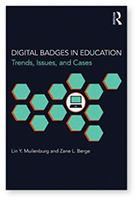 Digital Badges in Education: Trends, Issues, and Cases
Digital Badges in Education: Trends, Issues, and Cases
edited by Lin Y. Muilenburg and Zane L. Berge, Routledge, New York, N.Y., 2016, 288 pp. with index, $52.95 softcover
School leaders at both the building and district levels continually attempt to identify strategies that enable them to offer their staff individualized professional development. That is, meeting the needs of each individual staff member with regards to professional development, versus the whole group professional development traditionally still found in schools today.
Digital badges in education and what is known as micro-credentialing may be the answer to this particular dilemma. This online-based, visual representation maintains a record of achievements and credentials of individuals. For example, much like a newly hired individual at a given workplace setting would complete an online training where a certificate of completion is earned and confirmed by the individual’s employer, digital badges and micro-credentialing work in analogous fashion. Thus, school leaders can individualize and differentiate professional development focused on what each teacher or administrator requires with regards to their own professional development, and likewise, confirm completion. That is, afterwards, such individuals receive a “digital badge” or “micro-credential” for successful completion of the online training, much like a certificate of completion in the example provided.
In Digital Badges in Education: Trends, Issues, and Cases, Lin Muilenburg and Zane Berge provide what is perhaps the most comprehensive overview of this emerging tool to date. In addition, through the utilization of several case studies, the book explores all necessary components of badging systems, including their functions, value and possible predicaments that may arise from the use of such badging systems in the formal, informal and crowd-sourced educational settings for preK-12 students, higher education and adult learning.
As it relates to school leaders and the importance of school leaders being life-long learners, several examples are shared on how digital badges are being utilized for continuing education, namely in a higher education setting (think Harvard Extension School).
Many states, if not all, require school leaders to complete additional education or training to renew professional licenses and certifications. Thus, digital badging systems would allow school leaders to complete this additional education and training online when it may be more conducive to their schedules. After all, as we know, both building and district school leaders continue to work long days in our nation’s schools. This flexibility with regards to their continuing education would certainly be beneficial.
As we continue to move toward more flexible online educational opportunities for all individuals in the 21st century, I believe this book is highly valuable to all school building and district stakeholders, including students, staff, parents, community members and business owners.
Reviewed by Denver J. Fowler, assistant professor of educational leadership and policy studies, California State University, Sacramento, Calif.
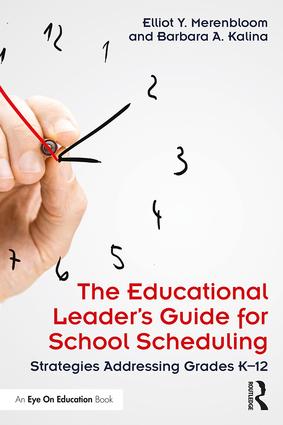 The Educational Leader’s Guide for School Scheduling: Strategies Addressing Grades K-12
The Educational Leader’s Guide for School Scheduling: Strategies Addressing Grades K-12
by Elliot Y. Merenbloom and Barbara A. Kalina, Routledge, New York, N.Y., 2017, 134 pp. with index, $34.95 softcover
Elliot Merenbloom and Barbara Kalina, long time educational consultants, have served education as teachers and school administrators. As educational consultants, they have authored The Educational Leader’s Guide for School Scheduling.
The authors have provided workshops and training for educators in the art of scheduling. This may be the major weakness in this book. The content presented here might serve well as material for their workshop, but falls short as a readable, understandable, coherent read by a single individual.
Each of the nine chapters in this book begins with a “Focus” that gives a clear statement of the contents of that chapter and concludes with a “Recap” and “Points to Consider.” All of this is informative and easy to understand, but the material presented in the rest of the chapter is not coherent.
There are 109 tables in this book, many of them hard to understand and in need of more clarification.
SInce this book is written as a resource for educators who are involved with scheduling, not many principals, counselors and others will find it useful.
Reviewed by Darroll Hargraves, retired superintendent and management consultant, School and Community Resources, Wasilla, Alaska
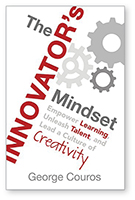 The Innovator’s Mindset: Empower Learning, Unleash Talent, and Lead a Culture of Creativity
The Innovator’s Mindset: Empower Learning, Unleash Talent, and Lead a Culture of Creativity
by George Couros, Dave Burgess Consulting, Inc., San Diego, Calif., 2015, 232 pp., $24.95 softcover
In
The Innovator’s Mindset: Empower Learning, Unleash Talent, and Lead a Culture of Creativity, author George Couros walks the reader through the process of innovation in our world of education today. He gets quickly to the point of innovation’s place in education by writing, “If students leave school less curious than when they started, we have failed them.”
Couros is a leading educator in the area of innovation, leadership, teaching and learning. He has worked in all levels of school, from K-12 as a teacher and technology facilitator to a building and district administrator. He is also the founder of
ConnectedPrincipals.com, which creates a global opportunity for educational leaders.
The book is broken into four sections, each one discussing at length the process of empowering a culture of innovation and creativity for ourselves, our teachers and students to thrive. Each section includes resources of related materials from books and YouTube videos to reinforce learning. The author devotes one chapter to creating meaningful learning experiences for educators that is perhaps worth the price of the book.
Our students, teachers and leaders live in a world with the ability to learn at any time, any place and at any pace. As educators, we must be innovative in order to bring these groups into our world of learning. The author encourages educators to jump in and take advantage of the same opportunities for learning that our kids do every day.
Reviewed by Jim Hattabaugh, educational consultant, Fort Smith, Ark.
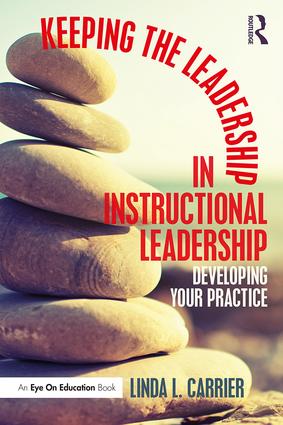 Keeping the Leadership in Instructional Leadership: Developing Your Practice
Keeping the Leadership in Instructional Leadership: Developing Your Practice
by Linda L. Carrier, Routledge, New York, N.Y., 2017, 113 pp., $34.95, softcover
Linda Carrier, author of
Keeping the Leadership in Instructional Leadership: Developing Your Practice, is an assistant professor of educational leadership and graduate program advisor at Plymouth State University. She has served in a variety of principal roles at the K-8 level, as well as central administration, and specializes in providing quality leadership for underperforming schools.
This book is a study of instructional leadership practices and imparts support as well as guiding questions so that readers may develop their own practice. It can be a quick read or a slow read that includes personal reflection and perhaps group discussion.
The 113 pages are organized into six chapters, beginning with a conceptual presentation of instructional leadership that develops common language and background knowledge. The middle chapters discuss the work of the principal and principal leadership, and the final two chapters discuss barriers to instructional leadership and how to keep leadership in one’s practice. Every chapter includes questions for reflection and discussion, as well as references. The questions are great; many of the references are somewhat dated.
Carrier uses the voices of eight exemplar principals as they comment on different aspects of instructional leadership. This is what the reader may enjoy the most, i.e., hearing authentic personal reflections from professionals who “talk the talk” and “walk the walk.”
This is not a “how to,” nor is it an implementation guide. This reviewer believes that readers who are aspiring principals or relatively new principals will gain the most from this book, but it could also be helpful to practitioners who wish to refresh their own philosophy of instructional leadership and re-energize the “instructional” component of their leadership practice.
Reviewed by Marilyn King, deputy superintendent for instruction, Bozeman Public Schools, Bozeman, Mont.
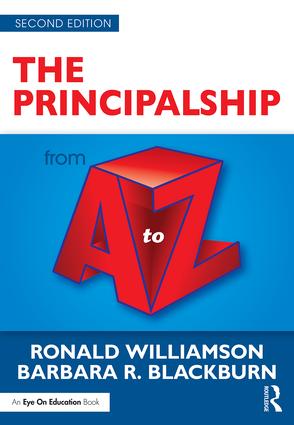 The Principalship from A to Z, 2nd edition
by Ronald Williamson
The Principalship from A to Z, 2nd edition
by Ronald Williamson and
Barbara R. Blackburn, Routledge, New York, N. Y., 2016, 228 pp., $34.95 softcover
Ronald Williamson is a professor of leadership and counseling at Eastern Michigan University and a former principal, central office administrator and executive director of the National Middle School Association. Barbara R. Blackburn is a former teacher of early childhood and former college professor at University of North Carolina-Greensboro who is a best-selling author of 15 books and a fulltime consultant. They have collaborated to provide a guide for principals in successfully leading a school.
The reviewer particularly liked the easy-to-read chapters and listing of resources at the end of each chapter should the reader want to explore a topic in more detail. Also, important information was bulleted and in a box to allow a quick review of the chapter. Each chapter contains practical tools, insightful tips, and reflective prompts, which are useful to novice administrators or for those who are experienced.
The reviewer believes the most important chapters were F, H, M and Q — Finding the Right People, How to Impact School Culture, Motivating Teachers, and Quality Teacher Evaluation.
In Finding the Right People, it was emphasized that a standard process should be used and that a list of qualities desired be identified prior to conducting the interview utilizing open-ended questions. The chapter also stressed the importance of keeping the right people and the uncomfortable job of terminating those teachers who are not a good fit for the students or the school culture.
In How to Impact School Culture, the authors defined culture as a complex set of values, traditions and patterns of behavior that are present in a school. Williamson and Blackburn discuss ways to influence culture, suggest activities prior to the opening of school and provide samples of opening day activities for staff.
In Motivating Teachers, intrinsic motivation was emphasized. The authors suggested ways to build teacher’s feelings of success and gave examples of encouraging phrases to use when having conversations with staff. Teachers are more motivated when they have ownership in the activity and they value their relationship with the administrator.
In Quality Teacher Evaluation, the authors emphasized the importance of the pre-observation conference, the post-observation conference and the art of asking open-ended questions, saying, “Criticism, like rain, should be gentle enough to nourish a man’s growth without destroying his roots.”
As a veteran educator, I enjoyed the easy-to-read chapters and could skip to the most interesting chapters first. I am comfortable recommending this book for all administrators and for those who aspire to become administrators.
Reviewed by Paul A. Shaw, director of educator ethics, Georgia Professional Standards Commission, Atlanta, Ga.
 You’re the Principal! Now What?: Strategies and Solutions for New School Leaders
by Jen Schwanke,
You’re the Principal! Now What?: Strategies and Solutions for New School Leaders
by Jen Schwanke, ASCD, Alexandria, Va., 2016, 342 pp. with index, $34.95 softcover
Jen Schwanke’s You’re the Principal, Now What? would be a nice gift for superintendents to give to principals and school leaders. Why? It is a smooth read, the content is digestible and the scenarios are based in reality.
The book is an overview of the world of a principal. Schwanke covers this through 18 chapters, with topics ranging from meeting staff to managing adult conflicts to managing your budget. I found myself nodding and shaking my head as I progressed through this book.
I came away with a book filled with notes. What did I scribble? These notes included ponderings as I questioned Schwanke in my mind, reflections, and do’s and don’ts in my new role in a new school. For the new and seasoned principal, this book can be used in professional learning communities within a district and as a suggested read for educator courses.
My one caution to the reader is about some of the terms in the book. For example, as a special education teacher, also known as a teacher of students with disabilities, I cringed at the use of SPED. The occasional use of IDEA, acronyms and a few examples feel authentic and we, as professionals, must realize that some terms are attached to specific education policies and laws. That is part of our lives and does not hinder one’s understanding of the content.
To come full circle, this book contains content applicable to new and veteran practitioners. Inevitably, it will prompt conversations. The overall positive tone in Schwanke’s writing leaves the reader with an upbeat place to start.
Reviewed by Hope Blecher, Curriculum Coordinator at Yeshivat He’Atid, an independent school in Teaneck, NJ.
ABSTRACT
Certification Programs
Do current superintendent preparation programs adequately ready individuals for the duties and responsibilities they will face every day?
In his doctoral dissertation at Indiana University of Pennsylvania, Robert M. Dufour conducted a series of semi-structured interviews with superintendents in New York. The interviews centered around their perceptions of their administrative preparation programs, internships and relevance of their coursework to their daily responsibilities.
Many felt their administrative preparation programs needed improvement, especially in areas like finance, budgeting and law.
Copies of “Study of Superintendents’ Perceptions of Current Superintendent Certification Programs in New York State” are accessible from ProQuest at 800-521-0600 or
disspub@proquest.com.
Why I Wrote this Book ...

“Administrators seek a clear teaching and learning guide that’s both useful and inspirational. I wanted to share hyper-practical strategies and guides to action that can be implemented immediately to accelerate school improvement. Storytelling woven throughout the six steps recognizes and celebrates the dedication and amazing work of colleagues in the field.”
Karen Goeller, deputy superintendent, Vigo County, Ind., and AASA member since 2017, on writing
Six Steps to Boost Student Learning: A Leader’s Guide (Eye on Education, 2017)
BITS & PIECES
School Characteristics
An estimated 90,400 public schools served nearly 49.3 million students in K-12 in the U.S. in 2015-16, according to a
new report from the National Center for Education Statistics.
Almost all public schools had at least one student with an individual education plan for special needs and 76 percent of schools offered courses for English language learners or limited English proficient students.
School Closures
Fewer than half of students whose schools closed for poor performance landed in better schools from 2006 to 2013, according to a
study by Stanford University’s Center for Research on Education Outcomes.
Mental Health
More than 25 million children in high-income countries have access to effective school-based mental health programs, according to an article in the
Harvard Review of Psychiatry.
Eight programs that focus on primary prevention or target vulnerable populations were profiled in the
article.
College Applications
A
report by the National Center for Education Statistics found nearly 80 percent of high school freshmen in 2009 applied or registered for postsecondary education in 2013.
State of the States
EducationSuperHighway has released its annual
State of the States report, providing an in-depth update on the status of broadband connectivity in the nation’s public schools.
The report found that more than 39 million students in America have access to high-speed internet at school, with 94 percent of school districts meeting the minimum kilobits per second rate set by the FCC in 2014.
Educator Preparation
A playbook of steps states can take to improve educator preparation has been released by the Council of Chief State School Officers.
The
guide, which was put together with the help of 15 states, shares successes and lessons learned to help other states prepare their educators to meet the needs of all students.
Cost Analyses
The National Center for Education Evaluation and Regional Assistance published a
brief for school leaders explaining how cost analyses can inform decision making in education.
Screen Time
Children who were read electronic books were more engaged during reading than those who were read print format books, according to a
study published in
Frontiers of Psychology.
AASA Campaign
AASA’s “
I Love Public Education” campaign provides school leaders with details on how to foster conversation on the essential role public schools play in a democracy. The content highlights the critical role public schools play to prepare today’s students and future generations to be contributing members to the civic life of their local, national and global community.
America is unique among developed countries in that it provides access and support to all students with the goal of being college- and career-ready.
Call for Papers
The
AASA Journal of Scholarship & Practice is a refereed, blind-reviewed, quarterly journal with a focus on research and evidence-based practice. It is designed to benefit AASA members and full-time and adjunct professors.
To review author guidelines, visit
www.aasa.org/jsp.aspx. The editor, Ken Mitchell, can be contacted at
kenneth.mitchell@mville.edu.
Fall Journal
The fall issue of AASA’s
Journal of Scholarship & Practice contains two research articles. One identifies 21 leadership responsibilities to consider when hiring school principals, and a second investigates evidence-based practices that contribute to student achievement.
A commentary and book review of
Excellence vs Equality: Can Society Achieve Both Goals are also included.
This issue and archives can be found at
www.aasa.org.